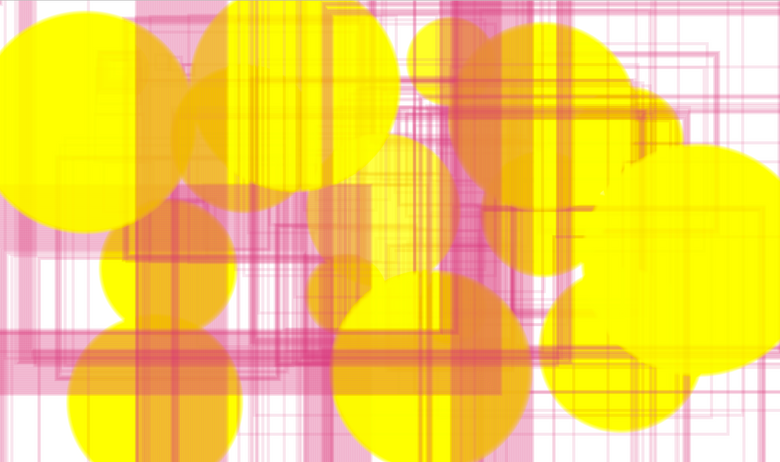
Grace A. Halverson | Anuraj Bhatnager | Katherine Bennett
The Effort of Conversation
Personality Exploration through Generative Art
Introversion and Extraversion are the extreme sides of a spectrum of behavioral patterns. Many people will self-identify as one or the other according to stereotypes, such as introverts prefer to be alone while extraverts prefer to party. These oversimplified stereotypes often cause misrepresentation and belittlement of an individual's social potential.
According to Jung's Theory of Introvert and Extravert Personalities, "[t]he introvert is more comfortable with the inner world of thoughts and feelings, so they will see the world in terms of how it affects them. While the extrovert feels more at home with the world of objects and other people, and is more concerned with their impact upon the world." The difference between how each sees the world and themselves in the world does not necessarily affect their willingness to participate as social beings, but rather how they respond to external stimuli.
In a conversational setting, the behavioral difference between personality types can be more obvious in the frequency, response time, and varying levels of intensity. We introduced elements of randomness to the appearance of both categories to represent a spectrum of potential within each. Although they are different, if the user allows both personality types to have an equal amount of ownership in a conversation, the result can be more beautiful than one or the other on its own. In our generative art project, we aimed to represent the presence of introvert and extravert behaviors in a conversation.
Extraversion
Cognitive research on extraversion has revealed a stronger positive correlation between neural activity and reward-sensitive regions of the brain than those who are categorized as more introverted. Often, individuals who are more eager to engage in gregarious activities are seeking positive responses from external stimuli and are thus categorized as extraverts.
In conversations, people who exhibit more eagerness to interact in social settings tend to start conversations more readily and break the ice. They are more likely to fill awkward silences and respond more quickly to new ideas or information than to internally reflect on new stimuli. The higher frequency of speech also leads to a higher probability that the extravert will "frame" the conversation.
We chose to represent extraversion as rectangles of varying color intensity, stroke weight, opacity, and size. The rectangles are continuously drawing at a higher speed than ellipses. In recognition that not all extraverts might aim to frame conversations, there is a possibility for the rectangle to be filled as well.


Introversion
People categorized as introverts can be just as influential in a conversation as their extraverted counterparts. However, they have a higher tendency to be more reflective on how they respond to outside stimuli. Often encouraging their participation requires more intentionality and time than with an extravert.
The introvert is executed by a right mouse click and is represented by a circle varying in color, opacity, and size. Each circle has the potential to take up as much of the conversation by making their presence as apparent as an extravert, but the user must be more intentional in clicking the right mouse key.
If the right mouse key goes unclicked, the conversational space will be dominated by the continuous rectangle draw feature (extraversion).
Mouse Clicks & Societal Perceptions
On a standard mouse there are left and right click buttons. The left click is often referred to as the "normal" click and has a higher frequency of usage. The right click is alternatively known as the "hidden options". Despite its smaller frequency of use, the right click has a lot of value - particularly it is often the button used to offer more information and more reflective explanations on something less readily understood to a user.
By assigning a right click to introverts, we are also aiming to reinforce the more modern perception of introversion. In Susan McCain's book, "Quiet", she breaks down the foundation of the socio-cultural tendency to stereotype the different personalities as positive or negative that still exists in the United States today. Capitalism and the Free Market encouraged society to see a big business approach as the "successful" mindset. Business is a fast-paced industry, where quick reaction times, memorable introductions, and big personalities often take centerstage. Our society has been reinforcing the notion that boldness equates confidence and thus success.
The Age of Technology, however, has allowed for less "loud" personalities to have access to the spotlight. Social Media activity has helped to exemplify that fast reaction times and louder personalities are not always "right". Typically, reflective and intentional responses gain more respect as they are more researched and carefully thought-out. This is not to say that now introversion is more correct than extraversion, but rather that there is value in both, especially when considering different contexts.
Our generative art project encourages the user to take the time to include more introverted personalities and reap the beautiful benefits of conversational inclusion from both sides of the personality spectrum.
More on Visuals
Check Out Our Code

References
https://fractalenlightenment.com/31622/life/jungs-theory-of-introvert-and-extrovert-personalities
https://www.ncbi.nlm.nih.gov/pmc/articles/PMC3129862/
https://callnerds.com/mouse-basics-left-vs-right-click/
http://psycnet.apa.org/record/1962-05735-001
https://academic.oup.com/scan/article/6/1/38/1604255 (Links to an external site.)
Cain, Susan. Quiet : [The Power of Introverts in a World That Can't Stop Talking]. New York :Random House, Inc. : Books on Tape, 2012. Audio Recording.





















